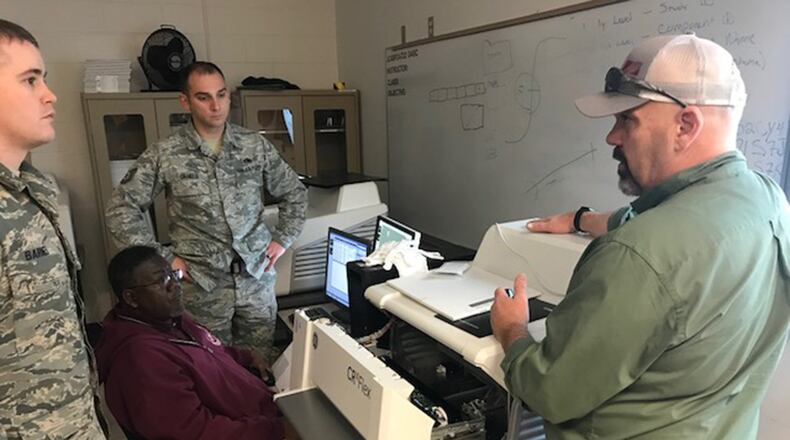The new process will impact every airframe the service flies, according to Michael Paulk, Air Force NDI Office chief.
“Every aircraft that we fly in the Air Force, whether it’s a manned or an unmanned aircraft, has some level of inspections that are required on a reoccurring basis,” Paulk said.
Nondestructive inspections are performed on many parts of an aircraft, including control surfaces, structural members and even engines, according to Paulk. They’re done after a set number of operating hours as well as when an aircraft encounters severe flying conditions or are subjected to hard landings or other incidents to determine the extent of damage.
“Just like the doctor might do an ultrasound, an MRI or an X-ray, we do basically the same thing to our patients – being airplanes and the components of airplanes,” said Paulk.
NDI X-rays were produced like they had been for decades, shot on special film that needed to be chemically processed. Now, for the price of 50 sheets of X-ray film, the Air Force can buy one digital plate that can be used 500 times.
“There’s a savings on the film itself. You’re saving the [cost of] development chemicals and, more importantly, you’re not having to pay money to dispose of [the chemicals] after it’s used and it becomes hazardous waste,” said Calvin Moore, AF NDI Office materials engineer.
Additionally, the digital format of the imagery allows for NDI technicians to use specialized software to enhance the images for clarity during diagnosis, according to Paulk. And, when technicians are unsure of a determination, the images can easily be electronically shared with experts for second opinions. Besides cost savings and flexibility, the system has even greater benefits.
“One of the real advantages, for our major command customers, is when they have to deploy,” Moore said.
Instead of having to transport four palettes of equipment when NDI technicians traditionally deploy – including film processors, chemicals and tanks to capture the hazardous materials – that’s been reduced down to one, according to Moore. Not only does that save on vital aircraft cargo space but it also leads to a much faster setup time – from at least two days required to reassemble equipment, install plumbing and set up environmental controls, down to four hours to set up a computer system and scanner.
Paulk said the program is like a three-legged stool – the equipment, the technical data and the technician – balanced when all the legs receive proper attention. With much help from AFRL’s Materials and Manufacturing Directorate, Air Force Sustainment Center NDI managers and Air Logistics Complex NDI teams, the technology was proven to meet Air Force requirements and adopted. As the technical data is being updated, AFLCMC is turning their attention to the people operating the equipment.
New NDI technicians will receive specific digital X-ray training in their initial apprentice training beginning in May, while legacy technicians will participate in regional training sessions to get up to speed on the new system as part of a “train the trainer” program, the first of which recently wrapped up at McEntire Joint National Guard Base, South Carolina, according to Moore.
Paulk says the Air Force has a contract in place to buy the first batch of computed radiography systems and will put those in operational guard and reserve units first. AFLCMC hopes to transition all legacy X-ray systems to the new digital system within the next five years.
About the Author
